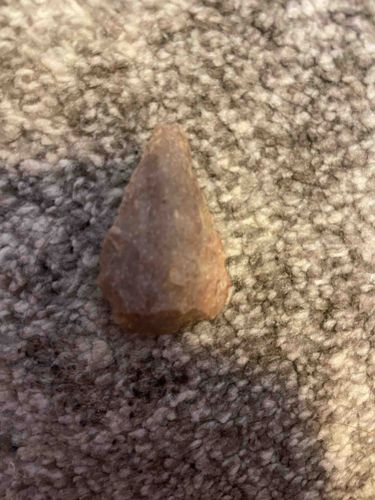
Stone Projectile Point (Conical)
The item appears to be a stone tool, specifically a flaked projectile point or a type of burin/engraving tool, given its pointed form and apparent modification. It is small in size, consistent with hand-held use or attachment to a shaft. The material is a fine-grained stone, likely chert, flint, or quartzite, exhibiting a reddish-brown to tan color palette. The surface shows distinct evidence of systematic flaking, indicating intentional modification by human hands through a lithic reduction process. There are visible flake scars across its surface, forming a conical or pyramidal shape, tapering to a relatively sharp point at one end. The base, or broader end, appears to be raw or less-worked, suggesting it might have been hafted or held in hand. There are no obvious signs of significant damage like large chips or breaks, though minor wear and a natural patina consistent with age and exposure are present. The craftsmanship suggests a basic but effective knapping technique. No maker's marks or signatures are discernible, as is typical for prehistoric tools. The overall style points to a prehistoric or aboriginal origin, possibly dating back hundreds or thousands of years, depending on archaeological context which is not available here. Its prime quality indicator is its evident functionality as a piercing or cutting implement.
AI-Generated Appraisal Disclaimer
Estimated Value
$75 - $150
Basic Information
Category
Archaeological Artifact/Tool
Appraised On
December 4, 2025
Estimated Value
$75 - $150
Item Description
The item appears to be a stone tool, specifically a flaked projectile point or a type of burin/engraving tool, given its pointed form and apparent modification. It is small in size, consistent with hand-held use or attachment to a shaft. The material is a fine-grained stone, likely chert, flint, or quartzite, exhibiting a reddish-brown to tan color palette. The surface shows distinct evidence of systematic flaking, indicating intentional modification by human hands through a lithic reduction process. There are visible flake scars across its surface, forming a conical or pyramidal shape, tapering to a relatively sharp point at one end. The base, or broader end, appears to be raw or less-worked, suggesting it might have been hafted or held in hand. There are no obvious signs of significant damage like large chips or breaks, though minor wear and a natural patina consistent with age and exposure are present. The craftsmanship suggests a basic but effective knapping technique. No maker's marks or signatures are discernible, as is typical for prehistoric tools. The overall style points to a prehistoric or aboriginal origin, possibly dating back hundreds or thousands of years, depending on archaeological context which is not available here. Its prime quality indicator is its evident functionality as a piercing or cutting implement.
Related Tags
Get Your Items Appraised
Instant estimates of your treasures with AI-powered instant appraisals